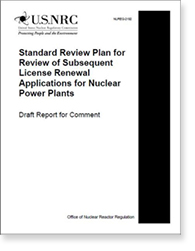A Letter to Nuclear Regulatory Commission
Michel Lee, Esq.
Chairman, Council on Intelligent Energy & Conservation Policy (CIECP)
February 29, 2016
 RE: Docket ID NRC-2015-0251
RE: Docket ID NRC-2015-0251
Comments of the Council on Intelligent Energy & Conservation Policy (CIECP), on Draft NUREG, NUREG-2191, “Generic Aging Lessons Learned for Subsequent License Renewal (GALL-SLR) Report, Volume 1 and Volume 2,” and draft NUREG-2192, “Standard Review Plan for Review of Subsequent License Renewal Applications for Nuclear Power Plants” (SRP-SLR).
The entire edifice of the scheme rests upon the false construct that the NRC can predict the effects of aging in systems which have not yet had experience with significant aging. This assumption would be shaky even if licensing—and relicensing—were limited to a year or two. It is preposterous with respect to the prolonged durations envisioned in the NRC’s regulatory scheme.
As a preliminary point, it bears mention that the Fukushima-Daiichi meltdown occurred in the site’s 41st year, in the aftermath of a 10 year relicensing authorization. Regardless of the contribution of aging at that site, it begs the question: What would have been the scale of the disaster had the accident occurred during the plant’s 51st or 61st or 71st year?
Aging management is conflated with assurance of safe performance during extended operation.
The NRC’s entire schema is based on hypothesis, not validated experiential whole system operational data.
Understanding of the effects of aging—for any complex installation, much less one operating under conditions of extreme pressure, heat and radioactivity—requires substantial accumulation and analysis of evidence of the actual performance of many such installations under real world conditions for many years. As a matter of irrefutable fact, there exists no such evidence for aged nuclear plants. The US fleet of reactors is largely either approaching or just near past 40 years of operation. There is no way to know how even the most robust well maintained plants will respond under duress of time.
For the many U.S. plants which have already had significant and repeated operational problems, the added variable of decades is a sure multiplier of uncertainty. Indian Point, for example, in its first 40 years of operation has already had multiple fires, explosions, cooling system malfunctions, clogged water intakes, boric acid corrosion, reactor control rod malfunctions, emergency backup generator failures, emergency communication system failures, computer software problems, pipe breaks, and radiation leaks. In the past year alone, the site experienced a transformer fire, an alarm failure, a power failure in the reactor core, and a new tritium leak. An NRC Special Inspection Team dispatched to Indian Point following the plant’s most recent transformer explosion, fire and oil leak—which occurred on May 9, 2015—determined that valves in the switchgear room designed to open to spray water malfunctioned because parts were corroded and clogged with debris. The valves leaked water into the switchgear room, and the water pooled because the drain on the floor was partially clogged with debris. (Special Inspection Report 05000286/2015010, Jul 23, 2015.) We should not need to remind the NRC of the risks inherent in the flooding of a switchgear room. Submersion of electrical components could disable switchgears and lead to station blackout or worse.
The NRC compiles information on degradation of components and systems (C&S) taken from studies on discrete C&S and specific plant findings. The NRC no doubt also does its best in the Proposed Rule to incorporate lessons learned. But when, where, and how does the NRC audit its own overall pattern of prediction performance? As far as we can tell, there has never been such an audit, nor does the agency appear to recognize such critical evaluation is an imperative. Alternatively, if such an audit has been conducted in recent years, the public deserves to know the results.
Profound trust in unflagging foresight is further unwarranted given the multiple uncertainties inherent in nature and climate change. The NRC cannot seriously contend, for example, that climate change would not exert a multiplier effect on the aging mechanisms applicable to reactors, spent fuel pools, and ancillary support C&S. For a wide assortment of risks—flooding risk, dam failure risk, earthquake risk, landslide risk, hurricane risk, tornado risk, site fire risk, and wildfire risk—small risks can grow pretty exponentially when combined and when the time periods are long. Modest, even minor degradation of discrete C&S may not, in and of themselves present significant risk, but the NRC scheme fails to consider the potential risks inherent in a site bearing multitudes of “acceptably” degraded C&S, especially under high load pressures such as a beyond design basis event leading to prolonged accident conditions.
Again, imagine if Fukushima had experienced another decade or two of normal aging before mother nature struck its devastating blow. Plants like Indian Point are disasters waiting to happen. Aging of increasingly deteriorated reactors is not going to be magically eradicated by piecemeal modifications and patches. As former NRC chairman, Gregory B. Jaczko, most aptly put it:
“Continuing to put Band-Aid on Band-Aid is not going to fix the problem.”
Michel Lee, Esq.
Chairman, Council on Intelligent Energy & Conservation Policy (CIECP)
